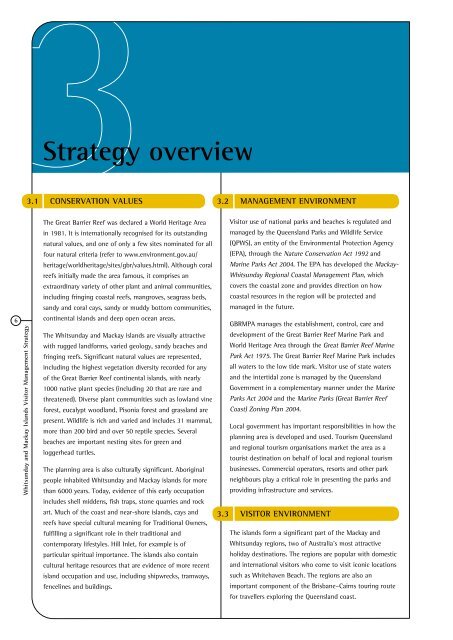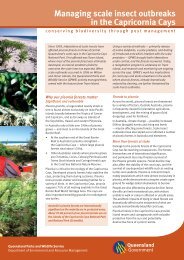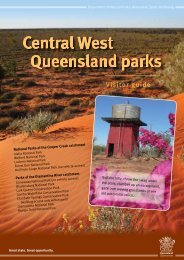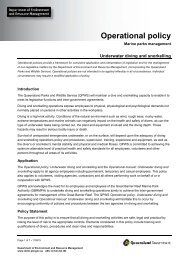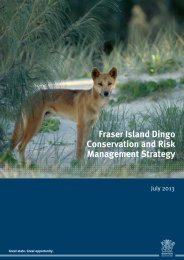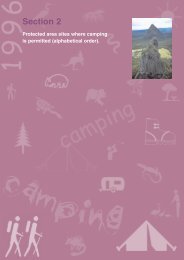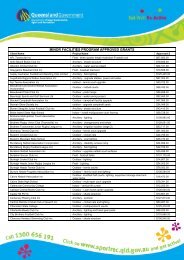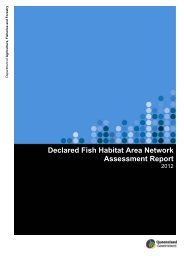Whitsunday and Mackay Islands Visitor Management Strategy ...
Whitsunday and Mackay Islands Visitor Management Strategy ...
Whitsunday and Mackay Islands Visitor Management Strategy ...
You also want an ePaper? Increase the reach of your titles
YUMPU automatically turns print PDFs into web optimized ePapers that Google loves.
<strong>Strategy</strong> overview<br />
3.1 Conservation values<br />
3.2 <strong>Management</strong> environment<br />
<br />
<strong>Whitsunday</strong> <strong>and</strong> <strong>Mackay</strong> Isl<strong>and</strong>s <strong>Visitor</strong> <strong>Management</strong> <strong>Strategy</strong><br />
The Great Barrier Reef was declared a World Heritage Area<br />
in 1981. It is internationally recognised for its outst<strong>and</strong>ing<br />
natural values, <strong>and</strong> one of only a few sites nominated for all<br />
four natural criteria (refer to www.environment.gov.au/<br />
heritage/worldheritage/sites/gbr/values.html). Although coral<br />
reefs initially made the area famous, it comprises an<br />
extraordinary variety of other plant <strong>and</strong> animal communities,<br />
including fringing coastal reefs, mangroves, seagrass beds,<br />
s<strong>and</strong>y <strong>and</strong> coral cays, s<strong>and</strong>y or muddy bottom communities,<br />
continental isl<strong>and</strong>s <strong>and</strong> deep open ocean areas.<br />
The <strong>Whitsunday</strong> <strong>and</strong> <strong>Mackay</strong> isl<strong>and</strong>s are visually attractive<br />
with rugged l<strong>and</strong>forms, varied geology, s<strong>and</strong>y beaches <strong>and</strong><br />
fringing reefs. Significant natural values are represented,<br />
including the highest vegetation diversity recorded for any<br />
of the Great Barrier Reef continental isl<strong>and</strong>s, with nearly<br />
1000 native plant species (including 20 that are rare <strong>and</strong><br />
threatened). Diverse plant communities such as lowl<strong>and</strong> vine<br />
forest, eucalypt woodl<strong>and</strong>, Pisonia forest <strong>and</strong> grassl<strong>and</strong> are<br />
present. Wildlife is rich <strong>and</strong> varied <strong>and</strong> includes 31 mammal,<br />
more than 200 bird <strong>and</strong> over 50 reptile species. Several<br />
beaches are important nesting sites for green <strong>and</strong><br />
loggerhead turtles.<br />
The planning area is also culturally significant. Aboriginal<br />
people inhabited <strong>Whitsunday</strong> <strong>and</strong> <strong>Mackay</strong> isl<strong>and</strong>s for more<br />
than 6000 years. Today, evidence of this early occupation<br />
includes shell middens, fish traps, stone quarries <strong>and</strong> rock<br />
art. Much of the coast <strong>and</strong> near-shore isl<strong>and</strong>s, cays <strong>and</strong><br />
reefs have special cultural meaning for Traditional Owners,<br />
fulfilling a significant role in their traditional <strong>and</strong><br />
contemporary lifestyles. Hill Inlet, for example is of<br />
particular spiritual importance. The isl<strong>and</strong>s also contain<br />
cultural heritage resources that are evidence of more recent<br />
isl<strong>and</strong> occupation <strong>and</strong> use, including shipwrecks, tramways,<br />
fencelines <strong>and</strong> buildings.<br />
<strong>Visitor</strong> use of national parks <strong>and</strong> beaches is regulated <strong>and</strong><br />
managed by the Queensl<strong>and</strong> Parks <strong>and</strong> Wildlife Service<br />
(QPWS), an entity of the Environmental Protection Agency<br />
(EPA), through the Nature Conservation Act 1992 <strong>and</strong><br />
Marine Parks Act 2004. The EPA has developed the <strong>Mackay</strong>-<br />
<strong>Whitsunday</strong> Regional Coastal <strong>Management</strong> Plan, which<br />
covers the coastal zone <strong>and</strong> provides direction on how<br />
coastal resources in the region will be protected <strong>and</strong><br />
managed in the future.<br />
GBRMPA manages the establishment, control, care <strong>and</strong><br />
development of the Great Barrier Reef Marine Park <strong>and</strong><br />
World Heritage Area through the Great Barrier Reef Marine<br />
Park Act 1975. The Great Barrier Reef Marine Park includes<br />
all waters to the low tide mark. <strong>Visitor</strong> use of state waters<br />
<strong>and</strong> the intertidal zone is managed by the Queensl<strong>and</strong><br />
Government in a complementary manner under the Marine<br />
Parks Act 2004 <strong>and</strong> the Marine Parks (Great Barrier Reef<br />
Coast) Zoning Plan 2004.<br />
Local government has important responsibilities in how the<br />
planning area is developed <strong>and</strong> used. Tourism Queensl<strong>and</strong><br />
<strong>and</strong> regional tourism organisations market the area as a<br />
tourist destination on behalf of local <strong>and</strong> regional tourism<br />
businesses. Commercial operators, resorts <strong>and</strong> other park<br />
neighbours play a critical role in presenting the parks <strong>and</strong><br />
providing infrastructure <strong>and</strong> services.<br />
3.3 <strong>Visitor</strong> environment<br />
The isl<strong>and</strong>s form a significant part of the <strong>Mackay</strong> <strong>and</strong><br />
<strong>Whitsunday</strong> regions, two of Australia’s most attractive<br />
holiday destinations. The regions are popular with domestic<br />
<strong>and</strong> international visitors who come to visit iconic locations<br />
such as Whitehaven Beach. The regions are also an<br />
important component of the Brisbane–Cairns touring route<br />
for travellers exploring the Queensl<strong>and</strong> coast.


